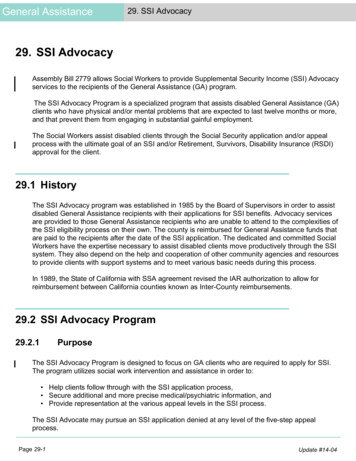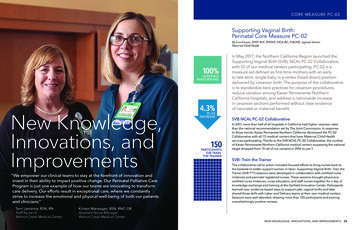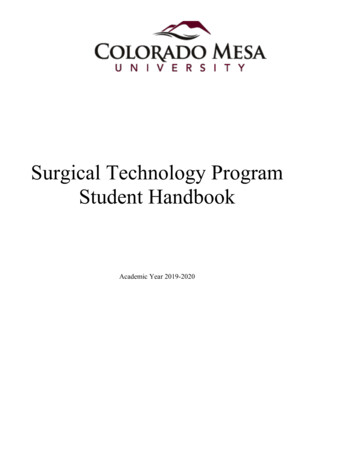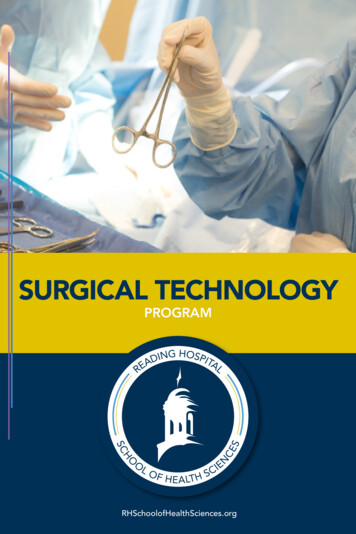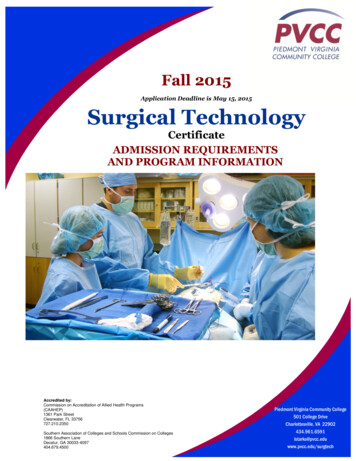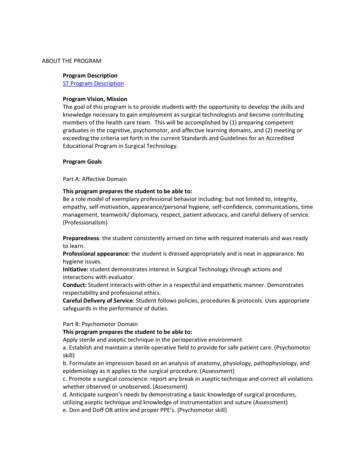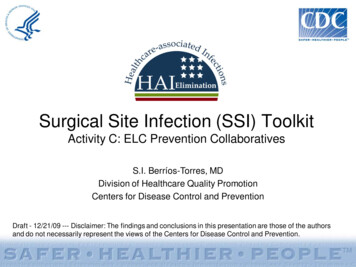
Transcription
Surgical Site Infection (SSI) ToolkitActivity C: ELC Prevention CollaborativesS.I. Berríos-Torres, MDDivision of Healthcare Quality PromotionCenters for Disease Control and PreventionDraft - 12/21/09 --- Disclaimer: The findings and conclusions in this presentation are those of the authorsand do not necessarily represent the views of the Centers for Disease Control and Prevention.
Outline Background– Impact– HHS Prevention Targets– Pathogenesis– EpidemiologyPrevention Strategies– Core– SupplementalMeasurement– Process– OutcomeTools for Implementation/Resources/References
Background: ImpactBurden-US 300,000 SSIs/yr (17% of all HAI; second to UTI) 2%-5% of patients undergoing inpatient surgeryMortality 3 % mortality 2-11 times higher risk of death 75% of deaths among patients with SSI are directlyattributable to SSIMorbidity long-term disabilitiesAnderson DJ, etal. Strategies to prevent surgical site infections in acute care hospitals.Infect Control Hosp Epidemiol 2008;29:S51-S61 for individual references
Background: ImpactLength of Hospital Stay 7-10 additional postoperative hospital daysCost 3000- 29,000/SSI depending on procedure & pathogen Up to 10 billion annually Most estimates are based on inpatient costs at time ofindex operation and do not account for the additionalcosts of rehospitalization, post-discharge outpatientexpenses, and long term disabilitiesAnderson DJ, etal. Strategies to prevent surgical site infections in acute care hospitals.Infect Control Hosp Epidemiol 2008;29:S51-S61 for individual references
Background: HHS Prevention Targets Reduce the admission and readmission SSIStandardized Incidence Ratio (SIR) by at least25% from baseline– Outcome – SSI SIR 95% adherence rates to each SCIP/NQFinfection process measure– Process - Adherence to SCIP/NQF infectionprocess evtargets.htmlAppendix G
Background: PathogenesisPathogen SourcesEndogenous Patient flora– skin– mucous membranes– GI tract Seeding from a distant focus of infection
Background: PathogenesisPathogen SourcesExogenous Surgical Personnel (surgeon and team)– Soiled attire– Breaks in aseptic technique– Inadequate hand hygiene OR physical environment and ventilation Tools, equipment, materials brought to theoperative field
Background: PathogenesisOrganisms Causing SSIJanuary 2006-October 2007Staphylococcus aureusCoagulase-negative staphylococciEnterococcus spp.Escherichia coliPseudomonas aeruginosaEnterobacter sppKlebsiella pneumoniaeCandida spp.Klebsiella oxytocaAcinetobacter 6%N 7,025Hidron AI, et.al., Infect Control Hosp Epidemiol 2008;29:996-1011Hidron AI et.al., Infect Control Hosp Epidemiol 2009;30:107–107(ERRATUM)
Background: EpidemiologyEmerging ChallengesChallenges in detecting SSIs Lack of standardized methods for postdischarge/outpatient surveillance– Increased number of outpatient surgeries– Shorter postoperative inpatient staysAntimicrobial Prophylaxis Increasing trend toward resistant organisms mayundermine the effectiveness of existingrecommendations for antimicrobial prophylaxis
Background: EpidemiologyImportant Modifiable Risk Factors Antimicrobial prophylaxis– Inappropriate choice (procedure specific)– Improper timing (pre-incision dose)– Inadequate dose based on body mass index,procedures 3h, or increased blood loss Skin or site preparation ineffective– Removal of hair with razors Colorectal procedures– Inadequate bowel prep/antibiotics– Improper intraoperative temperature regulation
Background: EpidemiologyAdditional Modifiable Risk Factors Excessive OR trafficInadequate wound dressing protocolImproper glucose controlColonization with preexistingmicroorganisms Inadequate intraoperative oxygenlevels
Prevention Strategies Core Strategies– High levels ofscientific evidence– Demonstratedfeasibility SupplementalStrategies– Some scientificevidence– Variable levels offeasibility*The Collaborative should at a minimum include core preventionstrategies. Supplemental prevention strategies also may be used.Most core and supplemental strategies are based on HICPACguidelines. Strategies that are not included in HICPAC guidelines willbe noted by an asterisk (*) after the strategy. HICPAC guidelines maybe found at www.cdc.gov/hicpac
Prevention Strategies: CorePreoperative MeasuresAdminister antimicrobial prophylaxis inaccordance with evidence based standards andguidelines– Administer within 1 hour prior to incision* 2hr for vancomycin and fluoroquinolones– Select appropriate agents on basis of Surgical procedure Most common SSI pathogens for the procedure Published recommendations*Fry DE. Surgical Site Infections and the Surgical Care Improvement Project (SCIP): Evolution of NationalQuality Measures. Surg Infect 2008;9(6):579-84.
Prevention Strategies: CorePreoperative Measures Remote infections-whenever possible:– Identify and treat before elective operation– Postpone operation until infection has resolved Do not remove hair at the operative site unless itwill interfere with the operation; do not use razors– If necessary, remove by clipping or by use of adepilatory agent
Prevention Strategies: CorePreoperative Measures (continued) Skin Prep– Use appropriate antiseptic agent and technique forskin preparation Maintain immediate postoperativenormothermia* Colorectal surgery patients– Mechanically prepare the colon (Enemas, catharticagents)– Administer non-absorbable oral antimicrobial agentsin divided doses on the day before the operation*Fry DE. Surgical Site Infections and the Surgical Care Improvement Project (SCIP): Evolution of NationalQuality Measures. Surg Infect 2008;9(6):579-84.
Prevention Strategies: CoreIntraoperative Measures Operating Room (OR) Traffic– Keep OR doors closed during surgery exceptas needed for passage of equipment,personnel, and the patient
Prevention Strategies: CorePostoperative Measures Surgical Wound Dressing– Protect primary closure incisions with steriledressing for 24-48 hrs post-op Control blood glucose level during theimmediate post-operative period (cardiac)*– Measure blood glucose level at 6AM on POD#1and #2 with procedure day POD#0– Maintain post-op blood glucose level at 200mg/dL Discontinue antibiotics within 24hrs aftersurgery end time (48hrs for cardiac)**Fry DE. Surgical Site Infections and the Surgical Care Improvement Project (SCIP): Evolution of NationalQuality Measures. Surg Infect 2008;9(6):579-84.
Prevention Strategies: SupplementalPreoperative Nasal screen and decolonize onlyStaphylococcus aureus carriers undergoingelective cardiac and other procedures (i.e.,orthopaedic, neurosurgery procedures withimplants) with preoperative mupirocintherapy*Bode LGM, etal. Preventing SSI in nasal carriers of Staph aureus. NEJM2010;362:9-17 Screen preoperative blood glucose levels andmaintain tight glucose control POD#1 andPOD#2 in patients undergoing select electiveprocedures (e.g., arthroplasties, spinal fusions)*NOTE: These supplemental strategies are not part of the 1999 HICPAC Guideline for Prevention ofSurgical Site Infections
Prevention Strategies: SupplementalPerioperative Redose antibiotic at the 3 hr interval inprocedures with duration 3hrs (* See exceptions to thisrecommendation in*Engelman R, et al. The Society of Thoracic Surgeons PracticeGuideline Series:Antibiotic Prophylaxis in Cardica Surgery, Part II:Antibiotic Choice. AnnThor Surg 2007;83:1569-76 Adjust antimicrobial prophylaxis dose forobese patients (body mass index 30)*AndersonDJ, Kaye KS, Classen D, et al. Strategies to prevent surgical site infections in acute carehospitals. Infect Control Hosp Epidemiol 2008;29 (Suppl 1):S51-S61 Use at least 50% fraction of inspiredoxygen intraoperatively and immediatelypostoperatively in select procedure(s)*MaragakisLL, Cosgrove SE, Martinez EA, et al. Intraoperative fraction of inspired oxygen is amodifiable risk factor for surgical site infection after spinal surgery. Anesthesiology2009;110:556-562. andMeyhoff CS, Wetterslev J, Jorgensen LN, et al. Effect of high perioperative oxygenfraction on surgical site infection and pulmonary complications after abdominal surgery:The PROXI randomized clinical trial. JAMA 2009;302:1543-1550.NOTE: These supplemental strategies are not part of the 1999 HICPAC Guideline for Prevention ofSurgical Site Infections
Prevention Strategies: SupplementalPostoperative Feedback of surgeon specific infectionrates.
Measurement: Surgical CareImprovement Project (SCIP)Process MeasuresQuality IndicatorNumeratorDenominatorAppropriate antibioticchoiceNumber of patients whoreceived the appropriateprophylactic antibioticAll patients for whomprophylactic antibioticsare indicatedAppropriate timing ofprophylactic antibioticsNumber of patients whoreceived theprophylactic antibioticwithin 1hr prior toincision (2hr:Vancomycin orFluoroquinolones)All patients for whomprophylactic antibioticsare indicatedAppropriatediscontinuation ofantibioticsNumber of patients who All patients whoreceived prophylacticreceived prophylacticantibiotics and had them antibioticsdiscontinued in 24 h(48h cardiac)Fry DE. Surgical Site Infections and the Surgical Care Improvement Project (SCIP):Evolution of National Quality Measures. Surg Infect 2008;9(6):579-84.
Measurement: Surgical CareImprovement Project (SCIP)Process Measures (continued)Quality IndicatorNumeratorDenominatorAppropriate hairremovalNumber of patientswho did not have hairremoved or who hadhair removed withclippersAll surgical patientsNormothermiaNumber of patientswith postoperativetemperature 36.0oCAll surgical patientsGlucose controlNumber of cardiacsurgery patients withglucose control at 6AMPOD1 and POD2(operation POD0)Patients undergoingcardiac surgeryFry DE. Surgical Site Infections and the Surgical Care Improvement Project (SCIP):Evolution of National Quality Measures. Surg Infect 2008;9(6):579-84.
Measurement: Outcome MeasuresSSI Rate# Patients with SSI after selected operations X100Total # of selected operations performed Crude, unadjusted rate Can lead to erroneous conclusions regarding SSIrisk by institution and/or surgeon NOT for reporting or inter-hospital comparisons
Measurement: Outcome Measures Risk Adjustment (1)NNIS Risk IndexScore to predict risk of acquiring SSIWidely used-targeted at surveillanceOperation-specificAllows monitoring of trendsFacilitates comparison– facility vs. nationalCulver DH, Horan TC, Gaines RP. Surgical infection rates by wound class, operative procedure,patient risk index. Am J Med;1991:152S-157S.
Measurement: Outcome MeasuresRisk Adjustment (2)NNIS Risk Index Focus on high volume operations Employs Risk Stratification– American Society of Anesthesiologists (ASA) score (3,4, or 5)– Wound Classification (contaminated or dirty)– Duration of Procedure (over T [proc specific] hours) Does not include many patient & perioperativerelated SSI risk factors Increased NNIS Risk index Increased risk ofSSICulver DH, Horan TC, Gaines RP. Surgical infection rates by wound class, operative procedure,patient risk index. Am J Med;1991:152S-157S.
Measurement: Outcome MeasuresRisk Adjustment (2)Standardized Incidence Ratio - SIRSIR Observed # SSIExpected # SSIExpected # SSI # operations* in each proc risk category X NNIS rate100 Value 1.0 more SSIs than expected Helps better identify outliers Will be used for comparison within NHSN in 2010*Performed by a surgeon, a surgical subspecialty service or a hospitalDetailed explanation and examples in: Edwards JR, Horan TC. Risk-adjusted Comparisons.In: Carrico R, ed. APIC Text of Infection Control and Epidemiology, 3rd ed. Washington DCAPIC 2009.Chapter 7, p.1-7.
Evaluation Considerations Assess baseline policies and procedures Areas to consider– Surveillance– Prevention strategies– Measurement Coordinator should track new policies/practicesimplemented during collaboration
References Casey AL, Elliott TSJ. Progress in the prevention of surgical siteinfection. Curr Opin Infect Dis 2009;22:370-375 Chong T, Sawyer R. Update on the epidemiology and prevention ofsurgical site infections. Curr Infect Dis Rep 2002;4:484-490) Department of Health and Human Services. Action Plan to PreventHealthcare-Associated /infection.html Accessed 17February 2010 Fry DE. A systems approach to the prevention of surgical infections.Surg Clin N Am 2009;89:521-537. Haynes AB, Weiser TG, Berry WR, et al,. A surgical safety checklistto reduce morbidity and mortality in a global population. N Eng J Med2009;360(5):491-499.
References Horan TC, Andrus M, Dudeck MA. CDC/NHSN surveillancedefinition of health care-associated infection and criteria for specifictypes of infections in the acute care setting. Am J Infect Cotrol2008;36:309-32 Kirby JP, Mazuski JE. Prevention of surgical site infection. SurgClin N Am 2009;89:365-389. Mangram AJ, Horan TC, Pearson ML, et al. Guideline for theprevention of surgical site infection, 1999. Hospital InfectionControl Practices Advisory Committee. Infect Control HospEpidemiol 1999; 20:250-278. McKibben L, Horan T, Tokars JI, et al. Guidance on PublicReporting of Healthcare-Associated Infections: Recommendationsof the Healthcare Infection Control Practices Advisory Committee.Am J Infect Control 2005;33:217-26.
References Nichols RL. Preventing surgical site infections. Clin Med Res2004;2(2):115-118. Travis J, Carr JB, Saylor D, et.al., Coronary Artery Bypass GraftSurgery: Surgical Site Infection Prevention. J Healthcare Quality2009;31:16-23 Trussell J, Impact of a patient care pathway protocol on surgical siteinfection rates in cardiothoracic surgery patients. Am J Surg2008;196:883-889. World Alliance for Patient Safety. WHO guidelines for safe surgery.Geneva: World Health Organization, 2008. Yokoe DS, Mermel LA, Anderson DJ, et.al. A compendium ofstrategies to prevent healthcare-associated infections in acute carehospital. Infect Control Hosp Epidemiol 2008:29:S12-S21.
ReferencesSSI Bundles Canadian Getting Started ons/SSI/Pages/ask.aspx (Select SSI Getting Started Kit) tm(Select “Power Point Presentation with /resources/SSIsummary.pdf
ReferencesSSI Bundles oads/prev surgical.pdf eventionBundle/aspx
Resources for ImplementationWHO Surgical Safety ChecklistWorld Health Organization. Safe Surgery Saves en/ Accessed 19 Nov 2009
Anderson DJ, etal. Strategies to prevent surgical site infections in acute care hospitals. . - Keep OR doors closed during surgery except as needed for passage of equipment, personnel, and the patient. . Risk Adjustment (1) NNIS Risk Index Score to predict risk of acquiring SSI Widely used -targeted at surveillance Operation-specific
